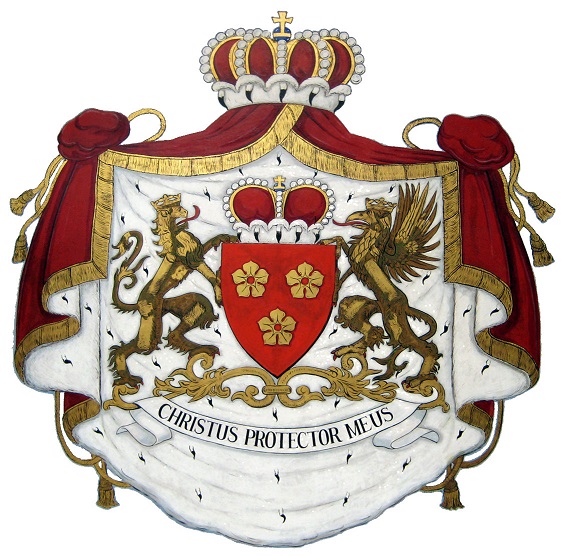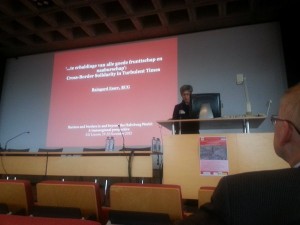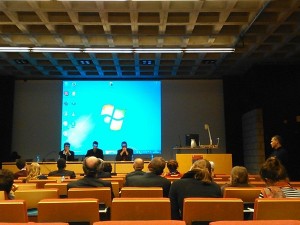
Conference Report of the Vth Arenberg Conference for History, sessions 1-2
By Bram De Ridder, Alexander Soetaert, and Sophie Verreyken
With borders again being at the centre of European politics, the Vth Arenberg Conference for history could hardly have come more timely. Focussing on ‘Barriers and Borders in and beyond the Habsburg World’, the papers and discussions on early modern transregional exchanges highlighted the constructed nature of borders and borderlands. At a time when freedom of movement is sharply questioned and a renewed closing of borders a prime issue, tracking the genesis of modern boundary regimes indeed proved highly interesting.
After a short introduction of the ‘Transregional History’ project by Professor Violet Soen, Luca Scholz of the European University Institute opened the first session. Discussing the practice of safe conduct (Geleit) in the Holy Roman Empire, Scholz really brought early modern borders to life. In contesting each other the right to escort prominent travellers (for example the Emperor), German princes, cities and other actors took a highly ‘performative’ approach to borders and barriers. Spatial elements which might seem trivial to contemporary eyes, for example a ditch in front of the city gates, were at the centre of various symbolic power struggles and became vital for displaying social and political prominence. Therefore, Scholz’s presentation really pointed to the man-made nature of early modern borders.
I n her paper on the orientation of the Duchy of Guelders towards the Holy Roman Empire, Raingard Esser likewise stressed how early modern people constructed or de-constructed their own borders. Professor Esser highlighted how (regional) solidarity could survive the creation of new ‘state’ borders for quite a long time, for example when a community on one side of the in 1648 created Habsburg-Dutch border supported the building of a church in a town on the other. Although the examples provided by professor Esser were in themselves highly revealing, she additionally pointed out that the real question is how long such reciprocal feelings exactly lasted. As such, her presentation opened up new and interesting lines of inquiry.
n her paper on the orientation of the Duchy of Guelders towards the Holy Roman Empire, Raingard Esser likewise stressed how early modern people constructed or de-constructed their own borders. Professor Esser highlighted how (regional) solidarity could survive the creation of new ‘state’ borders for quite a long time, for example when a community on one side of the in 1648 created Habsburg-Dutch border supported the building of a church in a town on the other. Although the examples provided by professor Esser were in themselves highly revealing, she additionally pointed out that the real question is how long such reciprocal feelings exactly lasted. As such, her presentation opened up new and interesting lines of inquiry.
Lastly, Annemieke Romein pointed out that not only solidarity could cross borders: political influence also extended from one country into another. Focussing on the billeting of troops in the German duchy of Julich, Romein demonstrated how the policies of neighbouring princes and of the Dutch Republic confronted the Duke and his subjects with several governmental difficulties, including an upsetting of the domestic political system. Indeed, her paper demonstrated that the influence of active and passive cross-border activities was an important, if not vital aspect of early modern politics.
Moving from the Holy Roman Empire to the Low Countries, the second session carried border creation as its central theme. Bram De Ridder contrasted the issuing of passports for persons to those issued for merchandize, shedding light upon a little know practice of the Eighty Years War. These passports were in fact one of the primary means by which the governments in The Hague and Madrid/Brussels could open or close their mutual border, demonstrating the role administrative practices could play in the control of territory. Moreover, through its increased usage the process of issuing passports gained a dynamic of its own, one which was shaped by border management strategies such as the copying of ideas or the discussing of traditional rights and freedoms.
 Secondly, Victor Enthoven turned to the mentioned commercial passports or licenten, as they not only formed an important means to control the border but also contributed significantly to the war-chests of both governments. Therefore, the issuing of licenten was often a highly contested matter, for example when it came to the ‘opening’ or ‘closing’ of trade on the river Scheldt. As professor Enthoven contended, in the Dutch Republic this debate centred around three distinct interests: the general objective of hurting the enemy, the considerations about financial revenue needed to continue the war, and the particular economic interests of the local province of Zeeland.
Secondly, Victor Enthoven turned to the mentioned commercial passports or licenten, as they not only formed an important means to control the border but also contributed significantly to the war-chests of both governments. Therefore, the issuing of licenten was often a highly contested matter, for example when it came to the ‘opening’ or ‘closing’ of trade on the river Scheldt. As professor Enthoven contended, in the Dutch Republic this debate centred around three distinct interests: the general objective of hurting the enemy, the considerations about financial revenue needed to continue the war, and the particular economic interests of the local province of Zeeland.
Finally, as last speaker for the second session featured professor Hans Cools, who discussed the political fate of Frisia during the Dutch Revolt and the reception of these events in contemporary historiography. Being a less well-studied province, Frisia became separated from Habsburg authority at a relatively early stage of the Revolt and consequentially could claim that its ‘garden’ had been closed entirely (an expression used to say that the territory of the province was secure). As such its trajectory differed from that of many other provinces in the Dutch Republic, changing its approach to its own borders and those of the generality accordingly. Being a fitting talk to end the first conference day, professor Cools’ paper drew particular attention to the fact that early modern Europe abounded with border zones, and that not only the boundaries of ‘big’ states are an interesting research topic.